Vancouver Canucks general manager Jim Benning and his NHL counterparts usually have the luxury of a picture that’s mostly come into focus.
A normal draft year will see scouts and executives spend the spring crisscrossing Europe and North America collecting every scrap of information possible on hockey’s next crop of high-end talent.
They watch games, talk to those closest to the prospects, conduct in-person interviews with players and examine physical testing results. The under-18 world championships, Canadian Hockey League playoffs and Memorial Cup are all on the list of must-attend events.
The circumstances surrounding a 2020 NHL draft and the COVID-19 pandemic, however, aren’t anything resembling normal.
The culmination of junior seasons were cancelled, tournaments were nixed and the league’s annual combine — a crucial exercise where teenage hopefuls are put through physical exercises and mental hula hoops — was postponed and looks unlikely to go ahead.
There’s talk the NHL could hold its draft online in the first part of next month even though the 2019-20 season has yet to be completed. But that’s far from the only unique aspect for teams poised to make franchise-altering decisions in this unprecedented era of social distancing.
In short, the book on many of the youngsters in question won’t be fully written.
“It’s nice to see how players perform in the playoffs,” Benning said. “That’s a big part, I think, of finding players that are winners … when it gets hard in the playoffs, if they step up. We’re going to miss out on all that.
“We’re trying to do the best we can under the circumstances to get to know the players and try to figure out what they’re going to be in three or four years time.”
Scouts logged plenty of kilometres until the novel coronavirus outbreak brought hockey to a halt in mid-March, but there was still lots of work to do, especially outside the top half of an opening round headlined by Alexis Lafreniere and Quinton Byfield.
“Probably not as complete as it would be had it been a normal ending to the season,” Columbus Blue Jackets GM Jarmo Kekalainen said of his team’s eventual list for the draft, which was originally scheduled for June 26-27 in Montreal. “You’re running around trying to (watch) the top guys one last time or guys that you had missed earlier in the year. Now we’re watching tape instead.
“It will be different coverage, not as good coverage … that’s the reason why we have the amateur scouts on the road. It’ll be a little bit different. It’ll be interesting and we’ll see how it goes.”
Winnipeg Jets GM Kevin Cheveldayoff said clubs will be forced to lean heavily on the work put in from September through early March heading into what’s expected to be a virtual draft similar to the one held by the NFL last month.
“We’ve always tried to keep a handle on times-seen of players … try to have a good balance,” he said. “Scouts, by their nature, live in the moment and go to the game and just hope the guy’s not hurt. They’ve always had to adjust.
“The interesting thing is we’re all in this same boat together. We all don’t have to pick or choose which game you’re going to, even though you’d love to be picking or choosing which game you’re going to.”
The NHL usually puts more than 100 draft prospects through physical testing at the combine next month. It’s also an opportunity for teams to hold one-on-one meetings in hopes of getting to know the player on a more intimate different level.
Like businesses, families and friends separated during the pandemic, team front offices are getting creative with video conferencing platforms, but there will be blind spots in other areas.
“The biggest thing losing the combine is physical testing,” Calgary Flames GM Brad Treliving said. “They all need to get stronger, but you get a sense of their frames and who needs what in terms of physical maturation.”
While clubs will be at an obvious disadvantage, Toronto Maple Leafs goalie Jack Campbell said some players could be in the same boat, especially with the need for remote interviews.
“I just enjoy face-to-face no matter what scenario it is,” said the 11th pick in the 2010 draft. “It’s just more real, I guess. But you’ve got to just make the most of what we’re given right now.
“It’s definitely a unique process for the prospects and the organizations.”
One that all involved, like the rest of society right now, will do their best to navigate.
“The work is still getting done,” Treliving said. “Ultimately you’re going to make decisions based on the information you have.”
-With files from Donna Spencer
This report by The Canadian Press was first published May 3, 2020.
___
Follow @JClipperton_CP on Twitter
Joshua Clipperton, The Canadian Press







